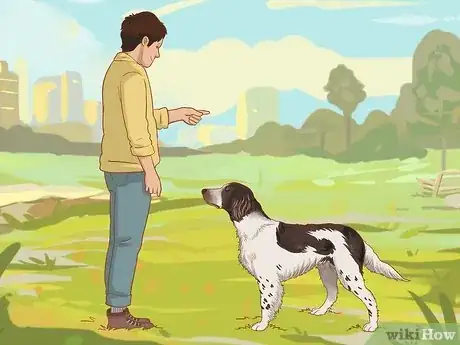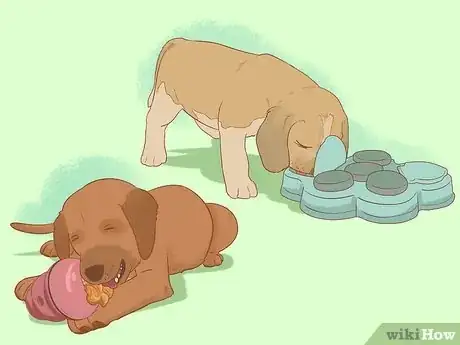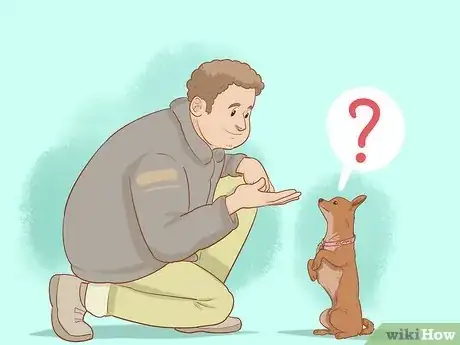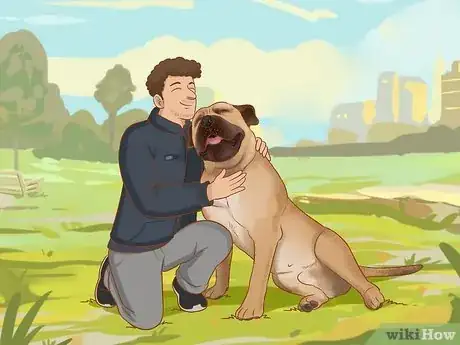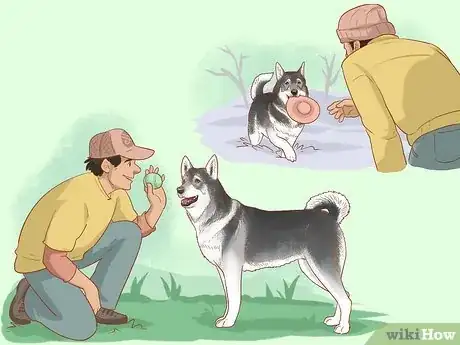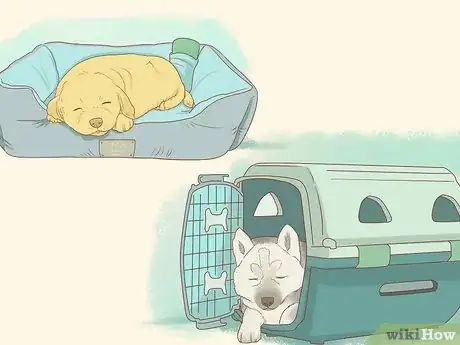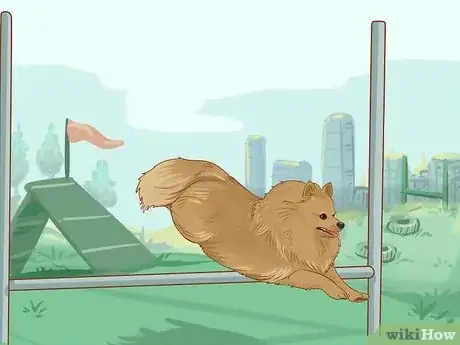This article was co-authored by Jessica Powell and by wikiHow staff writer, Aly Rusciano. Jessica is a Certified Professional Dog Trainer and the Owner of Proud Paws Dog Training, a small business offering private coaching and in-home dog training services to dog parents across the San Fernando Valley of Los Angeles, California. With nearly ten years of experience, she has extensive knowledge and experience in dog behavior, effective communication techniques, animal welfare, manners training, behavioral modification, and enrichment. Jessica holds a Bachelor of Science degree in Animal Management and is also an experienced shelter professional.
There are 10 references cited in this article, which can be found at the bottom of the page.
This article has been viewed 5,249 times.
Dogs have fears just like us. Some dogs can be shyer than others, but with a bit of training and lots of love, you can help them build their confidence! We’ve put together a list of ways to ease your furry friend’s anxieties and expose them to new situations. So, grab your pup’s favorite treats and keep reading to learn how you can build your dog’s confidence.
Steps
Teach your dog new tricks.
-
Reward-based training is a great way to boost confidence. If your dog has been acting extra shy lately, help them break out of their shell with praise and bonding time. Your furry friend will feel so proud when they master a new trick, and they’ll appreciate the extra belly rubs![1] X Research source Try teaching your pup these confidence-boosting tricks:
Feed your dog using puzzle toys.
-
Puzzle toys can help give your dog a sense of accomplishment. Like us, dogs get a sense of accomplishment when completing a puzzle, even if they are just in it for the treats. Putting their meals or snacks in a puzzle toy encourages them to experiment and problem solve, boosting their self-confidence and keeping them entertained. You can buy a puzzle toy at your local pet store, online, or even make your own. Check out these DIY puzzle toys you can make in a matter of minutes:[2] X Trustworthy Source Animal Humane Society Leading animal welfare nonprofit organization providing medical care, training education, and resources for animal owners Go to source
- Tennis ball treat puzzle: Cut along the seam of a tennis ball using a knife to create a flap. Fill the ball with a few treats, and roll it over to your pup.
- Muffin tin puzzle: Turn a muffin tin upside down and fill the space between the cups with dry food or treats.
Train your dog to play “touch.”
-
Learning touch will help your dog feel more confident in stressful situations. When a dog’s in an uncomfortable situation, it can be hard for them to focus. The “touch” exercise or game is a great way to help your dog refocus in any situation and feel proud. The praise you give when they’ve successfully done a new trick will boost their spirits and help them feel more confident overall. To teach “touch,” follow these steps:[3] X Research source
- Place smelly treats in your hands, moving them from one hand to another.
- Put a hand without treats in front of your dog about 1 inch (2.5 cm) away from their nose.
- Say “yes” and give your dog a treat when they touch their nose to your palm.
- Move your hand to a new spot and repeat.
- Add the word “touch” to the action once your dog touches your hand 100% of the time.
Use positive reinforcement.
-
Treats and belly rubs go a long when trying to boost your dog’s confidence. When it comes to dog training, the last thing you want to do is punish or yell at your furry friend, especially when they’re frightened. Rewarding good behavior with something positive like a treat, praise, or toy can help your dog differentiate between right and wrong. Here are some positive reinforcement tips and tricks:[4] X Trustworthy Source The Humane Society of the United States National organization devoted to the promotion of animal welfare Go to source
- Use short commands like “Yes!” or “Good dog!”
- Be consistent by continuing to praise specific behavior.
- Reward with small treats to not interrupt regular meal times.
- Use an enthusiastic and cheery tone when praising your dog.
Find new ways to play with your dog.
-
Engaging in fun activities can help boost your dog’s confidence over time. What dog doesn’t like experiencing new things? Exploring different games, tricks, and settings with your furry friend will boost their confidence and strengthen your bond as well! Try doing something your pup loves every day. Here are some ideas to get you started:[5] X Research source
- Play hide and seek with treats or toys
- Give them a cardboard box to play and hide in
- Go on a walk
- Visit a local park
- Host a playdate with other dogs
Make your dog a safe place.
-
Having a special space of their own can help build your dog’s confidence. Have you ever felt anxious or scared and just wanted to curl under the covers? Dogs feel the same way when they’re frightened. Building a comfortable place your pup can go to when they’re frightened can help them relax while also encouraging them to work through their fears on their own. This can be a dog bed, crate, or even a large pillow.[6] X Research source
- Your pup can view this small space as their own "territory."[7]
X
Expert Source

Dog Behavior Consultant Expert Interview. 5 March 2021. - If you travel a lot with you pup, bring their safe place along! This is a great way to keep them comfortable, happy, and confident on a long journey.
- Make sure you include plenty of toys in this special place, especially if your dog is a puppy.[8]
X
Expert Source

Dog Behavior Consultant Expert Interview. 5 March 2021.
- Your pup can view this small space as their own "territory."[7]
X
Expert Source
Have a routine your dog can rely on.
-
The predictability of structure can build up confidence. Dogs, especially puppies, thrive on set schedules and routines. If they know what will happen next, they’re less likely to be anxious.[9] X Trustworthy Source American Kennel Club The American Kennel Club (AKC) is a purebred dog pedigree registry in the United States. The AKC advocates for the responsible ownership of dogs and promotes purebred dog events, such as the Westminster Dog Show. Go to source If you have a nervous pup, try developing a set routine to ease their nerves and help them be the happiest they can be. Check out this example routine for a puppy:[10] X Trustworthy Source American Kennel Club The American Kennel Club (AKC) is a purebred dog pedigree registry in the United States. The AKC advocates for the responsible ownership of dogs and promotes purebred dog events, such as the Westminster Dog Show. Go to source
- Early morning: Take your pup on a walk to go potty.
- Breakfast: Give your pup a nutritious breakfast and plenty of water.
- After breakfast: Take your pup out one more time before work or school.
- Mid-morning: Let your pup rest and nap the morning hours away.
- Noon: Bring your pup on an afternoon walk and take time to play with them.
- Mid-afternoon: Allow your pup to nap again.
- Dinner: Feed your pup when you’re eating dinner.
- Evening: Take your pup on one final potty break and play with them right before bed.
Start agility training with your dog.
-
Conquering an obstacle course is a big confidence boost. Your pup will feel on top of the world once they’ve mastered the teeter-totter or jumped through a hoop! Agility course training is a great way to spend quality time with your dog and teach them that they can handle anything. You and your pup have to work together, stay focused, and trust each other.[11] X Trustworthy Source American Kennel Club The American Kennel Club (AKC) is a purebred dog pedigree registry in the United States. The AKC advocates for the responsible ownership of dogs and promotes purebred dog events, such as the Westminster Dog Show. Go to source
- Build a make-shift agility course in your own backyard by using large cardboard boxes as tunnels and hula hoops as a hoop jump.[12] X Trustworthy Source American Kennel Club The American Kennel Club (AKC) is a purebred dog pedigree registry in the United States. The AKC advocates for the responsible ownership of dogs and promotes purebred dog events, such as the Westminster Dog Show. Go to source
- Find local agility training classes by searching “dog agility training near me” online.
Desensitize your dog to triggers.
-
Expose you dog to something frightening and reward them with a treat. This technique is called counter conditioning and desensitization, and uses positive reinforcement to build your dog’s confidence and calm anxiety. First, identify your furry friend’s triggers. Once you know what’s triggering their fearful behavior, you can slowly start to expose them to it. Following your dog’s lead and being patient is extremely important. You want to gradually reintroduce a fear with positive reinforcement.[13] X Trustworthy Source Animal Humane Society Leading animal welfare nonprofit organization providing medical care, training education, and resources for animal owners Go to source
- For example, if your pup is afraid of the loud sound of a hair dryer, you can lower the intensity of the trigger by turning the dryer on and off quickly or turning it on in another room.
- Distract your pup with a treat when the hair dryer is on.
- If you brought the hair dryer into another room, try bringing it into the next closest room to your pup the next day.
Recognize when your dog is feeling anxious or scared
-
It's important to know when your dog is afraid. Paying close attention to their body language and behavior can help you recognize signs of anxiety and be your pup's advocate. Most dogs will run and hide with their tail between their legs if something frightens them. If they can’t move away from their fear, they may do one or more of the following:[14] X Trustworthy Source Animal Humane Society Leading animal welfare nonprofit organization providing medical care, training education, and resources for animal owners Go to source
- Appear uninterested
- Tremble or cower
- Yawn or pace
- Lunge at other humans or dogs
- Growl, whine, or bark
- If your dog shows any of these behaviors, don’t push them to face their fear right away. Your furry friend is uncomfortable, and the best thing you can do for them is be positive, kind, and patient.
You Might Also Like
 How Long Does it Take for Dogs to Get Unstuck After Mating?
How Long Does it Take for Dogs to Get Unstuck After Mating?
 10 Comforting Things to Say (or Text) to a Friend When Their Dog Dies
10 Comforting Things to Say (or Text) to a Friend When Their Dog Dies

 How to Sell Puppies
How to Sell Puppies

 12 Common Reasons Why Dogs Put Their Ears Back
12 Common Reasons Why Dogs Put Their Ears Back
 How to Get Dogs to Stop Eating Rabbit Poop
How to Get Dogs to Stop Eating Rabbit Poop
 How to Clean Dog Pee from a Mattress
How to Clean Dog Pee from a Mattress





References
- ↑ https://www.dogstrustusa.org/media/1159/building-confidence-in-general-dt-usa.pdf
- ↑ https://www.animalhumanesociety.org/news/brain-games-dogs
- ↑ https://lpchumanesociety.org/wp-content/uploads/Confidence-Building-Exercises-for-your-Dog.pdf
- ↑ https://www.humanesociety.org/resources/positive-reinforcement-training
- ↑ https://www.dogstrustusa.org/media/1159/building-confidence-in-general-dt-usa.pdf
- ↑ https://lpchumanesociety.org/wp-content/uploads/Confidence-Building-Exercises-for-your-Dog.pdf
- ↑ Amanda Marshall-Polimeni. Dog Behavior Consultant. Expert Interview. 5 March 2021.
- ↑ Amanda Marshall-Polimeni. Dog Behavior Consultant. Expert Interview. 5 March 2021.
- ↑ https://www.akc.org/expert-advice/training/how-to-train-fearful-dog/
- ↑ https://www.akc.org/expert-advice/training/setting-schedules-and-developing-a-routine-for-your-new-puppy/
- ↑ https://www.akc.org/expert-advice/training/agility-training-great-anxious-dogs/
- ↑ https://www.akc.org/expert-advice/training/agility-training-great-anxious-dogs/
- ↑ https://www.animalhumanesociety.org/behavior/counter-conditioning-and-desensitization
- ↑ https://www.animalhumanesociety.org/news/help-your-anxious-or-fearful-dog-gain-confidence
About This Article

